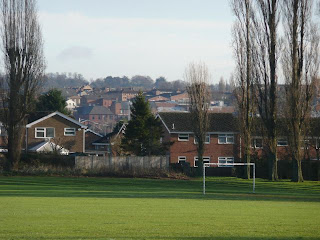There have been several messages responding to my recent post about final exams, with a number of questions about the British educational system. So, a primer:
The UK government provides free education to any child here beginning with Nursery School for age 3 and above. Nursery School is optional, but attendance is required for Primary School beginning at age five.
There is no "kindergarten," so five year olds begin at "Year One," and Primary School runs through "Year Six." However, in some areas there are separate buildings for "Infant School" (usually through Year Two, often with Nursery School in the same building) and "Junior School" (years Three through Six).
Beginning at age 11 (what would be sixth grade in the U.S.) students move to Secondary School, which runs through age 17 -- the end of compulsory education in the UK. Again, sometimes the secondary grades are split between different buildings, depending on local decisions.
In the Third Year of secondary school (around age 13) students make decisions about what subjects they will continue to study -- usually eight to ten, including maths (it's always plural here, never just "math"), English, one or more sciences, languages, art, music, etc. This is the beginning of their specialization.
At the end of Fifth Year of Secondary School (10th grade in the U.S. or roughly age 15) students take a battery of standardized tests known as GCSEs (General Certificate of Secondary Education) in their chosen subjects. How they do in these largely determines their future. Only those finishing in the upper half or so of GCSE scores will be university bound (but this is a much higher percentage than even a generation ago).
For historical reasons that no longer make much sense, the last two years of Secondary School are called "Sixth Form" or "College." (This is why it is so difficult for people here to get that "Luther College" provides university-level education. Over here, a "college" is a Sixth Form high school.) In Sixth Form, students choose to further narrow their studies to just three or four subjects.
At the end of Sixth Form there is another battery of standardized tests called "A-level Exams." Results of these exams come out in late July or early August, only about six weeks before the beginning of the university fall term, so there is a huge amount of chaos at this time as students find out if they will attend the university of their choice (to which they have been provisionally accepted based on a "prediction" of their A-level scores provided by their college instructors) or will have to enter the "clearing" process to find an open slot at some lesser institution.
The University of Nottingham, where our Luther students are studying, is considered a top-tier school, not quite up there with Oxford or Cambridge, but close behind. So they are in with some tough company when it comes to their academic peers.
 |
| King's College, Cambridge |
University is a three-year program, but there is no "liberal arts" curriculum, nor are there "general education" courses. Students select their major from day one, and that is all they study. So biology majors take only a set sequence of biology classes and labs, psychology majors study only psychology, English majors only "read English," etc.
Part of the challenge for our students is that if they take an upper-level class in, say, religion (to fulfill their Luther general education requirements for one basic and one upper-level religion course), they find themselves in a classroom full of religion majors who have studied nothing but that subject for the previous year or two. Same with any other course in any other subject.
One thing in our students' favor, however, is that their classes in all subjects have been -- by some measures -- somewhat more comprehensive: Classes at Luther, for example, all meet for 180 minutes per week (either 90 minutes TTh or 60 minutes MWF) for 15 weeks per semester. British university classes usually meet only once or twice a week for two, 10 or 11 week terms per year. And our students are already in their third year of a four year program.
The big controversy here is that university tuition, which was free prior to 1998, was capped at £3,290 (about $5,200) this year. Next year the tuition cap will rise to £9,000 (about $14,250 -- plus room and board, which for most is a rented "flat" off campus with several roommates). British students and their parents are questioning whether they will be getting their money's worth.
Thus, British students graduate from university at about age 20 or 21 and begin their careers very well-versed in just one subject in which they've specialized. Our students graduate at age 22 or 23, hopefully with a bit broader understanding of the world as a whole. But, at a substantially higher price.















